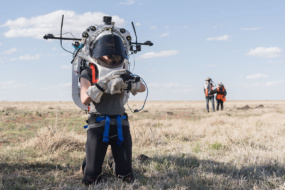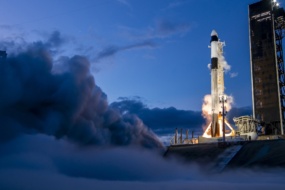China’s secretive military reusable space plane, which launched late last year, deployed an unidentified object into orbit last week. Although details on the object’s purpose and utility (if any) remain sparse, the spacecraft’s activities add to a growing list of operations closely monitored by US military officials.
Over the last decade, China has grown its military presence in space to include sophisticated space planes, recon birds, secure comms, SSA, and ASAT capabilities. In fact, according to data compiled by astronomer Jonathan McDowell, China has averaged more defense payloads (not including dual-use tech) deployed over the last four years than the US.
The US squeaked out ahead of China’s defense payload count last year, propelled by the Space Development Agency deployment of its first 23 Tranche 0 satellites. The US plans to further ramp up military satellite launches this year.
After the US and China, the rest of the world remains far behind. Notably, all of Europe launched just three defense payloads last year. Over the last decade, Europeans deployed no more than six defense payloads in a year.
Zooming in on China: China has doubled down on its activity in space over the last 10 years, viewing the domain as critical for national security.
China’s defense payload deployments have risen from 15 in 2014 to 42 in 2023.
“The PLA views space superiority, the ability to control the space-enabled information sphere and to deny adversaries their own space-based information gathering and communication capabilities, as a critical component to conduct modern ‘informatized warfare,’” the Pentagon wrote in its 2023 DoD report to congress on China’s military developments.
But What is China Launching?
The short answer is just about everything: space planes, remote recon sensing birds, satellite comms, and counterspace capabilities.
- Shenlong space plane: As mentioned at the onset of the article, one of China’s most mysterious payloads is its reusable Shenlong space plane.
- The spacecraft was launched just weeks before the US X-37B military space plane, and seems to bear many similarities.
- The only concrete information that we’ve been able to gather since the space plane deployed is that it has managed to raise its orbit.
- Yaogan remote sensing satellites: The majority of China’s defense satellites fall into the Yaogan satellite series, which includes optical, synthetic aperture radar (SAR), and electronic intelligence (ELINT) payloads.
- Maj. Gen. Gregory Gagnon, the deputy chief of space operations for intelligence, said this month that out of the 400+ satellites China has launched over the past two years, more than half of them are designed to keep eyes on Earth, Defense One reported.
- China has deployed dozens of electronic intelligence satellites, which can be used for maritime tracking by detecting ship radar and other electromagnetic signals. The country also launched the world’s first GEO SAR payload last year, dubbed Ludi Tance-4. The country
- Satellite comms: Last year, the Pentagon reported that the PRC operated more than 60 comms satellites, with at least four designated for military use. China is in the early days of developing large LEO satcom constellations, similar to Starlink, that will have dual-use utility to support government and national security applications. The planned constellations include:
- Guowang: 12,992 sats
- G60: 1,296 sats planned / 12,000 sats total
- Honghu-3: 10,000 sats
- Counterspace capabilities: In its 2023 China military development report to Congress, the DoD wrote that China is advancing capabilities to disrupt or deny adversaries’ space operations, including:
- Co-orbital satellites
- Electronic warfare systems
- Directed-energy systems
- Direct-ascent anti-satellite (ASAT) missiles
“In addition to the development of directed energy weapons and satellite jammers, the PLA has an operational ground-based anti-satellite (ASAT) missile intended to target low-Earth orbit satellites,” the DoD wrote in the report. “The PRC probably intends to pursue additional ASAT weapons capable of destroying satellites up to geosynchronous Earth orbit.”
In 2007, China conducted an ASAT test on one of its weather satellites, which created one of the largest space debris event in history.
Final thoughts: Over the past decade, the landscape of space defense has ballooned into various constellations of reconnaissance, surveillance, and communication capabilities. The US and China have emerged as primary competitors, but other nations remain active.
Despite Russia’s payload launches fluctuating over the years, the Kremlin continues to focus on strategic capabilities, including developing space-based anti-satellite nuclear weapons, emphasizing impact over quantity. North Korea is also aggressively pursuing a presence in space. The hermit kingdom, which deployed its first spy satellite last year, experienced a failed launch a few days ago as it also aims to ramp up its defense deployments.




